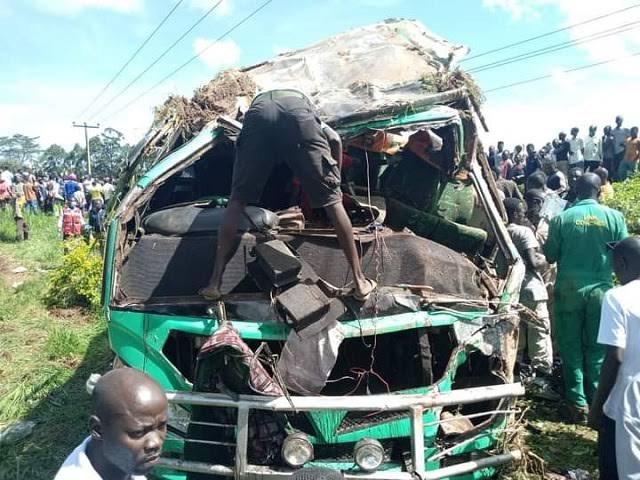The sun rises over Kampala, painting the city in hues of gold and dust. On Entebbe Road, the heartbeat of Uganda’s capital throbs with life: matatus honk like impatient drummers, boda-bodas dart through traffic like fireflies, and pedestrians weave through the chaos with the grace of survival. This is Uganda’s daily rhythm, a symphony of hustle—okwegatta—where every journey is a gamble. But beneath the noise lies a darker melody: the roads are bleeding, claiming lives in a relentless toll that scars the nation’s soul.
Aisha, a 17-year-old from Kyebando, pedals her bicycle toward school, her dreams of becoming a doctor tucked into her schoolbag. Her mother’s warning—“Okwetegyereza, mwana wange” (be careful, my child)—echoes faintly. But caution is no match for the chaos of Entebbe Road. A truck, its brakes worn thin by years of neglect, barrels past a faded speed limit sign. The screech of metal, a scream swallowed by the morning din, and Aisha’s dreams dissolve into the tarmac. A crowd gathers, muttering “kitalo”—how tragic—before dispersing. Aisha joins the grim tally: one of over 4,434 fatal crashes recorded.
Okello, a 40-year-old matatu driver from Nakasero, knows the roads’ dangers intimately. His cousin died in a head-on collision on Jinja Road in 2023, leaving behind a widow and four children. Yet Okello drives on, his 14-seater van groaning under the weight of 20 passengers, its tires as thin as hope. “If I don’t speed, I don’t eat,” he says, his voice heavy with resignation. A 2024 report by the World Health Organization notes that Uganda’s road fatality rate is 29 per 100,000 people, among Africa’s highest, with reckless driving and poor vehicle maintenance as key culprits. Okello’s van, like many, fails basic safety checks, a systemic issue highlighted by the Uganda Police Force’s 2024 data: 60% of vehicles in fatal crashes were unroadworthy.
In Gulu, 19-year-old Bosco rides a boda-boda to support his orphaned siblings. He learned to ride at 16, no license, no helmet—just a secondhand bike and sheer will. “The roads are my office,” he says, dodging potholes on the Gulu-Arua road. A 2024 Makerere University study found that boda-bodas account for 40% of road crash fatalities, with unlicensed riders and faulty bikes as major factors. Bosco’s friend Denis died in a lorry collision, a story echoed in a 2024 X post by @DailyMonitor: “Motorcycle fatalities have climbed above 20% over the past decade”. Bosco now wears a helmet, a lesson learned in blood.
In Kabale, Nalongo Grace mourns her 12-year-old son, Peter, killed by a speeding taxi while walking to school. The driver fled, leaving Peter’s exercise books scattered like broken promises. “He wanted to be an engineer,” Grace weeps, clutching his photo. A 2025 X post by @newvisionwire reports that 1,666 pedestrians died in 2024, with 13 perishing daily, a crisis sparking calls for a safety overhaul. Grace’s grief fuels her activism, joining village women demanding speed bumps near schools.
Uganda’s roads are a battlefield of systemic failures. The Kampala-Masaka highway, riddled with potholes, forces drivers into dangerous maneuvers. A 2025 article by D+C notes that 25,107 crashes occurred in 2024, a 6.4% increase from 2023, with 4,434 fatalities. Poor infrastructure, corruption, and reckless driving are the main drivers. Traffic police spokesperson Michael Kananura emphasizes personal responsibility, but corruption undermines enforcement, with officers often accepting bribes to overlook violations.
Boda-boda riders, often young and untrained, are a growing concern. A 2023 X post by @DailyMonitor highlights distracted driving, such as texting, as a common cause of crashes. Alcohol and aggressive driving by bus and lorry operators add to the chaos. In rural areas, roads lack signage and pedestrian crossings, exacerbating risks. A 2025 X post by @DrSerunjogiEmma criticizes steep fines—up to UGX 600,000 for speeding—when road signs are outdated or missing, reflecting public frustration with enforcement.
The hustle culture—okwegatta—fuels the crisis. Matatu drivers like Okello overload to maximize fares, while boda-boda riders like Bosco take risks to afford school fees. Pedestrians, like Peter, navigate roads with no sidewalks, pushed into traffic by illegally parked vehicles. The 2019 Road Act’s rules against such parking are rarely enforced, with 37% of 2023’s road deaths being pedestrians.
The government has taken steps, but they falter. The 2024 Traffic and Road Safety Regulations set speed limits—30 km/h in urban areas, 100 km/h on expressways—with fines up to UGX 600,000. Yet, enforcement is inconsistent, with mechanics disabling speed governors for bribes. The National Road Safety Action Plan (2021-2026) aims for 3-star or better roads, with a UGX 124 billion budget, but progress is slow. A 2018 WHO report notes that Uganda’s Legislative Action Plan, launched by Speaker Rebecca Kadaga, was Africa’s first, but implementation lags.
Communities are stepping up. In Mbarara, SafeBoda trains riders like Bosco, providing helmets and safety tips. In Gulu, mechanics inspect boda-bodas for free, fixing brakes and lights. In Bugiri, Elder Mukasa’s vigils along the Busia-Jinja road demand speed bumps, recently securing one near a school. A 2022 X post by @kizzabesigye1 calls for better road designs, driver certification, and policing, echoing public sentiment. Activist Sarah Nakimuli’s #SafeRoadsUganda campaign on X has amplified these voices, sharing stories of loss and demanding accountability.
Uganda’s roads are a mirror of its resilience and its wounds. They carry farmers to markets, children to schools, and dreams to reality—but at a devastating cost. The 2024 data—25,808 casualties, 4,434 deaths—tells a story of a nation bleeding out. Aisha, Sarah, Peter, and thousands more are not just numbers; they are Uganda’s heart, lost to preventable tragedies.
Yet, hope persists. Bosco rides with a helmet, Okello joins a drivers’ cooperative for better wages, and Grace speaks at community forums, her voice a beacon for change. The roads, scarred and stained, whisper a challenge: to build better infrastructure, enforce laws, and value life over haste. A 2025 X post by @SamsonMKasumba questions the narrative of “accidents,” calling out recklessness as the true culprit.
As the sun sets over the Nile, casting shadows on the tarmac, Uganda drives on. The crimson veins demand a reckoning—a nation’s promise to its people that no more dreams will bleed out on its roads. Will Uganda rise to the challenge, or will the toll continue to rise?
This post was created with our nice and easy submission form. Create your post!




